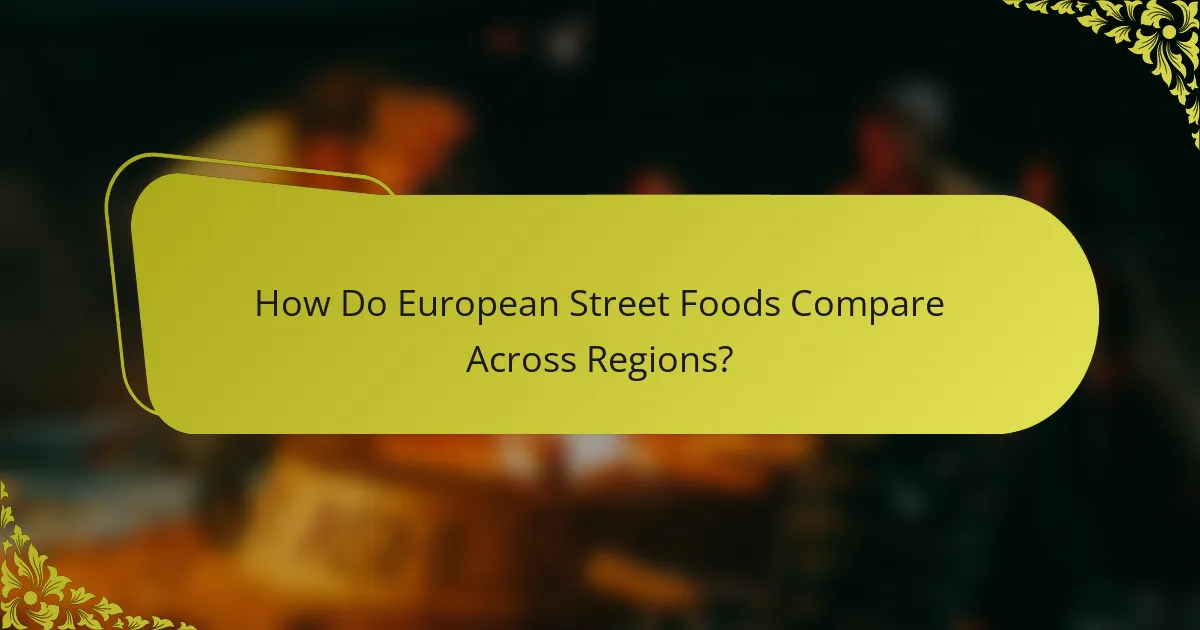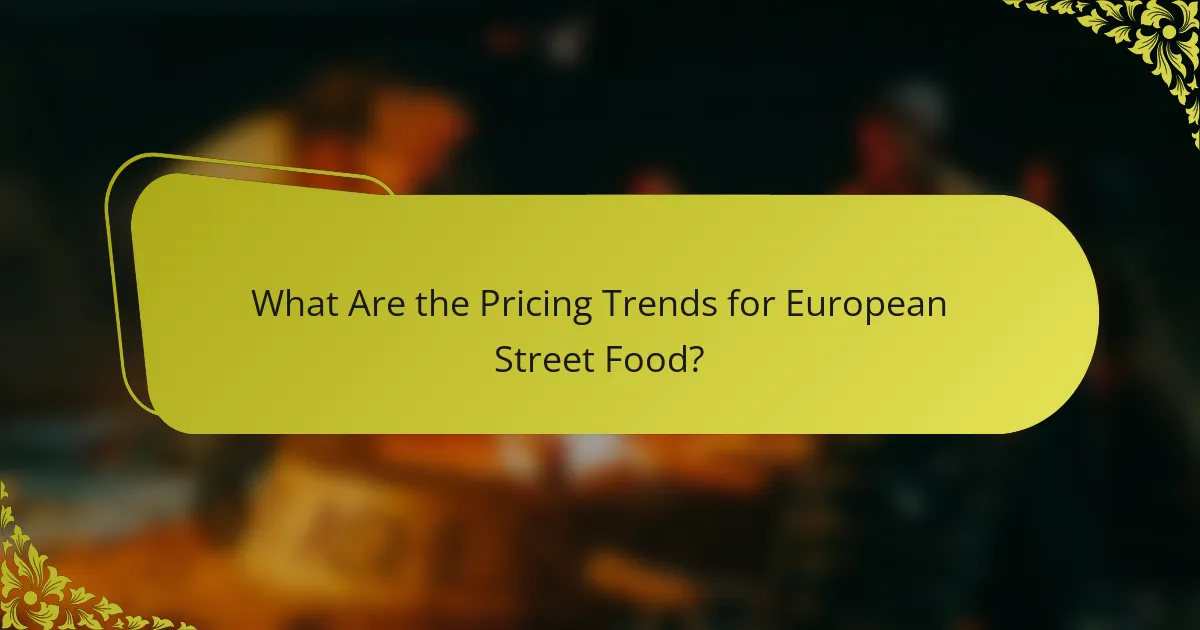In 2023, European street food trends highlight a blend of sustainability, creativity, and local flavors, with vendors increasingly offering plant-based options and fusion cuisines. The diversity of street food across regions showcases unique culinary traditions, from Southern Europe’s Mediterranean delights to Northern Europe’s hearty meat dishes. Major cities like Berlin and Barcelona present iconic offerings that reflect their rich cultural heritage and innovative culinary scenes.

What Are the Top European Street Food Trends in 2023?
In 2023, European street food trends are characterized by a growing emphasis on sustainability, creativity, and local flavors. Vendors are increasingly focusing on plant-based options, fusion cuisines, and artisanal snacks that reflect regional ingredients and culinary traditions.
Plant-based offerings
Plant-based street food is gaining traction across Europe, catering to the rising demand for vegetarian and vegan options. Dishes like jackfruit tacos, cauliflower wings, and chickpea falafel are becoming staples at food markets and festivals.
Many vendors are creatively incorporating local vegetables and grains, making these offerings not only healthy but also regionally relevant. For example, in the UK, you might find vegan fish and chips made from banana blossoms, while in Italy, plant-based arancini are popular.
Fusion cuisines
Fusion cuisines are blending traditional European dishes with global flavors, creating unique and exciting street food experiences. This trend often combines elements from different culinary traditions, such as Korean BBQ tacos or Indian-inspired pizza.
Food trucks and stalls are experimenting with these combinations, appealing to adventurous eaters. In cities like Berlin and Amsterdam, you can find dishes that mix Mediterranean spices with Nordic ingredients, showcasing the diversity of European street food.
Artisanal snacks
Artisanal snacks are becoming a highlight of the street food scene, with vendors focusing on high-quality, handcrafted items. These snacks often feature traditional recipes and techniques, such as handmade pretzels in Germany or freshly baked pastries in France.
Consumers are drawn to the authenticity and craftsmanship of these offerings, often willing to pay a premium for unique flavors and textures. Look for options like gourmet popcorn, specialty cheeses, or locally made charcuterie boards at street food events.
Gourmet food trucks
Gourmet food trucks are redefining the street food landscape by offering high-end dining experiences on the go. These mobile kitchens serve everything from gourmet burgers to upscale seafood dishes, often prepared by trained chefs.
In cities like Paris and Barcelona, food trucks are increasingly popular for their ability to deliver quality meals quickly and conveniently. Many of these trucks emphasize seasonal ingredients and innovative cooking techniques, attracting food enthusiasts seeking a unique dining experience.
Locally sourced ingredients
Using locally sourced ingredients is a key trend in European street food, as vendors aim to support regional farmers and reduce their environmental impact. This practice enhances the freshness and flavor of the dishes while promoting sustainability.
Street food vendors are often seen collaborating with local producers, creating menus that reflect the seasonal bounty of their area. For instance, in Italy, you might find street food featuring fresh truffles or locally caught seafood, emphasizing the connection between the food and its origins.

How Do European Street Foods Compare Across Regions?
European street foods vary significantly across regions, influenced by local ingredients, cultural traditions, and culinary practices. While Southern Europe leans towards Mediterranean flavors, Northern Europe often features heartier, meat-based offerings.
Southern Europe vs Northern Europe
Southern European street foods, such as tapas from Spain and arancini from Italy, emphasize fresh ingredients and vibrant flavors. These dishes often include vegetables, seafood, and herbs, reflecting the Mediterranean diet. Prices for street food in this region typically range from €2 to €10, making it accessible for casual dining.
In contrast, Northern European street foods like Danish hot dogs and British fish and chips focus on hearty, filling meals. These offerings often feature meats and potatoes, catering to colder climates. Expect to pay between €3 and €12 for these satisfying options.
Western Europe vs Eastern Europe
Western European street foods, such as crepes from France and currywurst from Germany, showcase a blend of international influences and local specialties. These foods often highlight convenience and quick service, with prices generally between €4 and €15. Popularity is driven by both locals and tourists seeking quick bites.
Eastern European street foods, including pierogi from Poland and langos from Hungary, tend to be more rustic and hearty. They often incorporate ingredients like potatoes, cabbage, and meats, reflecting the region’s agricultural heritage. Prices are usually lower, ranging from BGN 2 to BGN 8, making them an economical choice for street dining.

What Unique Street Food Offerings Are Found in Major Cities?
Major cities across Europe boast unique street food offerings that reflect their cultural heritage and culinary creativity. From Berlin’s iconic currywurst to Barcelona’s delightful tapas, each city presents a distinct flavor profile that captures the essence of its local cuisine.
Berlin’s currywurst
Currywurst is a beloved street food in Berlin, consisting of steamed and fried sausage sliced and topped with a tangy curry ketchup. This dish is often served with a side of fries or bread, making it a hearty snack or meal.
When exploring Berlin, visitors can find currywurst stalls throughout the city, particularly in busy areas like Kreuzberg and Mitte. Prices typically range from €2 to €5, depending on the vendor and portion size.
Barcelona’s tapas
In Barcelona, tapas are small plates of various dishes that encourage sharing and socializing. These can include anything from patatas bravas to seafood, cured meats, and cheeses, offering a taste of the region’s diverse culinary influences.
Tapas are commonly enjoyed in bars and restaurants, with prices varying widely. Expect to pay around €3 to €8 per dish, making it easy to sample multiple flavors in one outing. Pairing tapas with local wines enhances the experience.
London’s street markets
London’s street markets are a vibrant hub for diverse street food offerings, featuring everything from gourmet burgers to international cuisines. Markets like Borough Market and Camden Market showcase a wide array of options, catering to various tastes and dietary preferences.
Prices at these markets can range from £5 to £15 per dish, depending on the complexity and ingredients. It’s advisable to arrive hungry and explore different stalls to fully appreciate the culinary diversity available in the city.

What Are the Key Ingredients in Popular European Street Foods?
Popular European street foods often feature a combination of meats, seafood, vegetables, grains, spices, and sauces that reflect local tastes and traditions. These ingredients not only define the flavors but also showcase the diversity of culinary practices across the continent.
Meats and seafood
Meats and seafood are central to many European street foods, with options varying by region. In Southern Europe, you might find grilled meats like kebabs or skewers, while Northern countries often feature fish dishes, such as fish and chips or smoked salmon. Common meats include pork, chicken, and beef, often seasoned or marinated for added flavor.
Street vendors frequently use local meats, ensuring freshness and authenticity. For instance, in Spain, chorizo is a popular choice, while in Italy, porchetta sandwiches are a favorite. Seafood options like calamari or shrimp are also prevalent, especially in coastal areas.
Vegetables and grains
Vegetables and grains play a crucial role in European street foods, often serving as the base or side for meat dishes. Common grains include bread, rice, and potatoes, which are versatile and filling. For example, in Belgium, fries are a staple, served with a variety of sauces.
Vegetables are often grilled, pickled, or sautéed, adding color and nutrition to street food offerings. In Greece, for instance, you might find stuffed grape leaves or vegetable-based pitas that highlight local produce like tomatoes, cucumbers, and eggplants.
Spices and sauces
Spices and sauces enhance the flavors of street foods, with each region boasting its own unique combinations. Common spices include paprika in Hungary, herbs like oregano in Italy, and garlic across many cuisines. These ingredients not only add flavor but also reflect cultural heritage.
Sauces are equally important, ranging from simple condiments like ketchup and mayonnaise to more complex sauces like tzatziki or aioli. Vendors often offer a variety of sauces to cater to different tastes, allowing customers to customize their meals. For example, in Germany, currywurst is typically served with a tangy curry ketchup that adds a distinctive kick.

How to Choose the Best Street Food Vendors?
To choose the best street food vendors, prioritize health and safety standards, check customer reviews, and observe vendor popularity. These factors can significantly influence the quality and safety of the food you consume.
Health and safety standards
Health and safety standards are critical when selecting street food vendors. Look for vendors who adhere to local regulations, such as food handling certifications and cleanliness of their cooking area. In many European cities, vendors must display their hygiene ratings prominently.
Pay attention to the condition of the food preparation area and the personal hygiene of the vendor. A clean setup and the use of gloves or utensils can indicate a commitment to food safety.
Customer reviews and ratings
Customer reviews and ratings provide valuable insights into the quality of food and service offered by street vendors. Check online platforms or local food blogs for recent reviews, as they often highlight both positive experiences and potential issues.
Look for vendors with consistently high ratings and frequent positive feedback. A vendor with a strong online presence and numerous reviews is likely to be a safer choice.
Vendor popularity and foot traffic
Vendor popularity and foot traffic can be good indicators of quality. A busy vendor often signifies that their food is well-liked and trusted by locals. Long lines may suggest that the food is worth the wait.
However, consider the time of day and location; peak hours may skew perceptions of quality. If a vendor is consistently busy during off-peak hours, it’s a strong sign of their popularity and reliability.

What Are the Pricing Trends for European Street Food?
Pricing trends for European street food vary significantly across countries and regions, influenced by local ingredients, economic conditions, and consumer preferences. Generally, prices range from a few euros for simple snacks to higher amounts for gourmet offerings.
Average Prices Across Europe
In Western Europe, street food typically costs between €5 and €15, depending on the dish and location. For instance, a classic French crepe may be priced around €6, while a gourmet burger in a trendy area could reach €12 or more. In Eastern Europe, prices are often lower, with many options available for under €5.
Factors Influencing Pricing
Several factors impact street food pricing in Europe, including ingredient quality, preparation methods, and vendor location. High-quality, locally sourced ingredients tend to increase costs, while food trucks in busy tourist areas often charge more due to higher foot traffic. Seasonal variations can also affect prices, as certain ingredients may be more expensive during off-peak times.
Consumer Trends and Willingness to Pay
Consumers are increasingly willing to pay a premium for unique and high-quality street food experiences. Many are drawn to artisanal offerings that emphasize sustainability and local sourcing, which can command higher prices. Additionally, the rise of food festivals and markets has cultivated a culture where people are more open to trying diverse cuisines, often leading to higher spending on street food.
